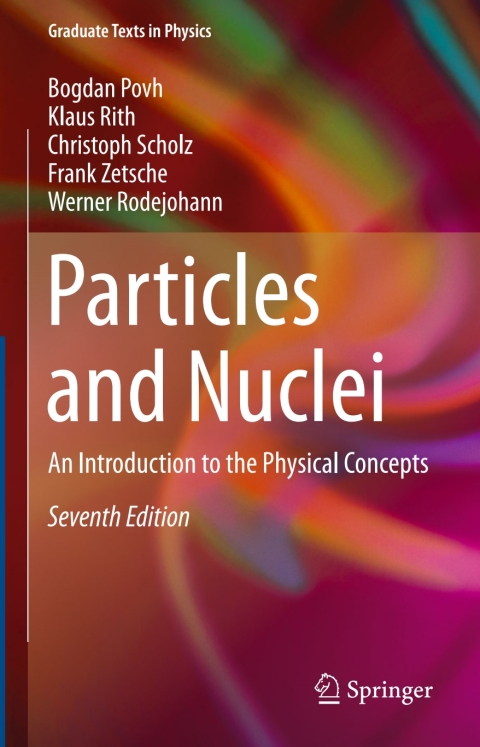Description
Efnisyfirlit
- Preface
- Preface to the First Edition
- Contents
- 1 Hors d’œuvre
- 1.1 Fundamental Constituents of Matter
- 1.2 Fundamental Interactions
- 1.3 Symmetries and Conservation Laws
- 1.4 Experiments
- 1.5 Units
- Reference
- Part I Analysis: The Building Blocks of Matter
- 2 Global Properties of Nuclei
- 2.1 The Atom and Its Constituents
- 2.2 Nuclides
- 2.3 Parametrisation of Binding Energies
- 2.4 Charge Independence of the Nuclear Force and Isospin
- Problem
- References
- 3 Nuclear Stability
- 3.1 Beta Decay
- 3.2 Alpha Decay
- 3.3 Nuclear Fission
- 3.4 Decay of Excited Nuclear States
- Problems
- References
- 4 Scattering
- 4.1 General Observations About Scattering Processes
- 4.2 Cross-Sections
- 4.3 The “Golden Rule”
- 4.4 Feynman Diagrams
- Problems
- References
- 5 Geometric Shapes of Nuclei
- 5.1 Kinematics of Electron Scattering
- 5.2 The Rutherford Cross-Section
- 5.3 The Mott Cross-Section
- 5.4 Nuclear Form Factors
- 5.5 Inelastic Nuclear Excitations
- Problems
- References
- 6 Elastic Scattering Off Nucleons
- 6.1 Form Factors of the Nucleons
- 6.2 Quasi-elastic Scattering
- 6.3 Charge Radii of Pions and Kaons
- Problems
- References
- 7 Deep-Inelastic Scattering
- 7.1 Excited States of the Nucleons
- 7.2 Structure Functions
- 7.3 The Parton Model
- 7.4 The Quark Structure of Nucleons
- 7.5 Interpretation of Structure Functions in the Parton Model
- Problems
- References
- 8 Quarks, Gluons, and the Strong Interaction
- 8.1 Quarks in Hadrons
- 8.2 The Quark-Gluon Interaction
- 8.3 Scaling Violations of the Structure Functions
- 8.4 Flavour-separated Parton Distributions
- 8.5 Nuclear Effects in Deep-Inelastic Scattering
- Problems
- References
- 9 Particle Production in e+e- Collisions
- 9.1 Lepton Pair Production
- 9.2 Resonances
- 9.3 Non-resonant Hadron Production
- 9.4 Gluon Emission
- Problems
- References
- 10 Phenomenology of the Weak Interaction
- 10.1 Properties of Leptons
- 10.2 The Types of Weak Interactions
- 10.3 Coupling Strength of the Weak Interaction
- 10.4 The Quark Families
- 10.5 Parity Violation
- 10.6 Deep-Inelastic Scattering with Charged Currents
- Problems
- References
- 11 Neutrino Oscillations and Neutrino Mass
- 11.1 Lepton Families
- 11.2 Neutrino Oscillations
- 11.3 Neutrino Oscillation Experiments
- 11.4 Majorana Neutrinos?
- Problems
- References
- 12 Exchange Bosons of the Weak Interaction and the Higgs Boson
- 12.1 Real W and Z Bosons
- 12.2 Electroweak Unification
- 12.3 Width of the Z0 and the Number of Neutrinos
- 12.4 Symmetry Breaking
- 12.5 The Higgs Boson
- 12.6 Grand Unification
- Problem
- References
- 13 The Standard Model
- Reference
- Part II Synthesis: Composite Systems
- 14 Quarkonia
- 14.1 The Hydrogen Atom and Positronium Analogues
- 14.2 Charmonium
- 14.3 Quark-Antiquark Potential
- 14.4 The Chromomagnetic Interaction
- 14.5 Bottonium and Toponium
- 14.6 The Decay Channels of Heavy Quarkonia
- 14.7 Decay Widths as a Test of QCD
- Problems
- References
- 15 Mesons
- 15.1 Meson Multiplets
- 15.2 Meson Masses
- 15.3 Decay Channels
- 15.4 Neutral-Kaon Decay
- 15.5 CP Violation and the CKM Matrix
- Problems
- References
- 16 Baryons
- 16.1 The Production and Detection of Baryons
- 16.2 Baryon Multiplets
- 16.3 Baryon Masses
- 16.4 Magnetic Moments
- 16.5 Spin Structure of the Nucleon
- 16.6 Semileptonic Baryon Decays
- 16.7 How Good Is the Constituent-Quark Concept?
- Problems
- References
- 17 The Nuclear Force
- 17.1 Nucleon-Nucleon Scattering
- 17.2 The Deuteron
- 17.3 Nature of the Nuclear Force
- Problems
- References
- 18 The Structure of Nuclei
- 18.1 The Fermi Gas Model
- 18.2 Hypernuclei
- 18.3 The Shell Model
- 18.4 Deformed Nuclei
- 18.5 Spectroscopy Through Nuclear Reactions
- 18.6 Beta Decay of the Nucleus
- 18.7 Double Beta Decay
- Problems
- References
- 19 Collective Nuclear Excitations
- 19.1 Electromagnetic Transitions
- 19.2 Dipole Oscillations
- 19.3 Shape Oscillations
- 19.4 Rotational States
- Problems
- References
- 20 Nuclear Thermodynamics
- 20.1 Thermodynamical Description of Nuclei
- 20.2 Compound Nuclei and Quantum Chaos
- 20.3 The Phases of Nuclear Matter
- 20.4 Particle Physics and Thermodynamics in the Early Universe
- 20.5 Stellar Evolution and Element Synthesis
- Problems
- References
- 21 Many-Body Systems in the Strong Interaction
- Reference
- Appendix A
- A.1 Accelerators
- A.2 Detectors
- A.3 Combining Angular Momenta
- A.4 Physical Constants
- Solutions to Problems
- Chapter 2
- Chapter 3
- Chapter 4
- Chapter 5
- Chapter 6
- Chapter 7
- Chapter 8
- Chapter 9
- Chapter 10
- Chapter 11
- Chapter 12
- Chapter 14
- Chapter 15
- Chapter 16
- Chapter 17
- Chapter 18
- Chapter 19
- Chapter 20
- References
- Index






Reviews
There are no reviews yet.